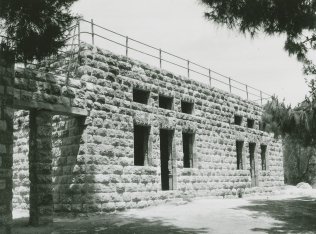| Year | Arab | Total |
|---|---|---|
| 1931 | 371 | |
| 1944/45 | 550 | 550 |
| Year | Arab | Public | Total |
|---|---|---|---|
| 1944/45 | 8202 | 155 | 8357 |
| Use | Arab | Public | Total | ||||||||||||
|---|---|---|---|---|---|---|---|---|---|---|---|---|---|---|---|
|
1641 | 152 | 1793 (21%) | ||||||||||||
|
6561 | 4 | 6565 (79%) |
The village was situated on undulating land in the western foothills of the Jerusalem heights. A secondary road linked it to the Gaza-Jerusalem highway that ran north of the village land. Seasonal dirt roads also connected it to the villages of Dayr Muhaysin and Bayt Susin. At the beginning of this century the village had a rectangular plan, narrow streets, and mud-and-stone houses. Its population was predominantly Muslim. The village center included a mosque, some shops, and a school, built in 1947, which was co-financed and shared with the neighboring village of Bayt Susin. Bayt Jiz's economy was based on agriculture. The villagers grew a variety of crops, including grain, vegetables, figs, almonds, and olives. They planted olives on 14 dunums of their land. In 1944/45 a total of 6,525 dunums was allotted to cereals; 36 dunums were irrigated or used for orchards. One part of the surrounding land was grassland, which enabled the villagers to raise sheep and goats, while another part was wooded. Several archaeological sites and khirbas were near Bayt Jiz.
All the villages in the Jerusalem corridor that did not fall during Operation Nachshon (see Bayt Naqquba, Jerusalem sub-disctrict) were occupied in the subsequent battles around al-Latrun in May and June 1948. Bayt Jiz was occupied in the interval between the first and second assaults on al-Latrun, i.e., between 15 May and 30 May. The New York Times reported that an unsuccessful Israeli attack on al-Latrun on 25 May spread to Bayt Jiz and Khulda the following day. The paper's correspondent called the battle around Bayt Jiz and Khulda 'the biggest single clash of the war to date.' On 28 May, the Israeli army officially announced the capture of the village after they swept south of the Jerusalem-Jaffa road. According to the History of the War of Independence, Bayt Jiz and Bayt Susin fell to the newly-formed Sheva' (Seventh) Brigade in the context of Operation Ben-Nun. The occupation of the two villages enabled Israeli forces to establish an alternative supply line to Jerusalem that bypassed al-Latrun.
Israeli historian Benny Morris notes that a military assault on the village took place during the previous month, on 20 April, and the residents were displaced at that time. However, Palestinian historian 'Arif al-'Arif writes that the initial attempt to occupy Bayt Jiz took place on 22-23 May and that it failed partly because Israeli forces had received mistaken reports about the evacuation of the village. Consequently, they were surprised to encounter fierce resistance from the inhabitants of Bayt Jiz and Bayt Susin, as well as from regular Arab forces in the al-Latrun sector. AI-'Arif adds that both villages fell in a subsequent attack on 30 May.
Three Israeli settlements are on village land: Har'el (145135), founded in 1948; Tzelafon (143134), founded in 1950; and Gizo (144134), founded in 1968.
The site, overgrown with wild vegetation, is used as a recreation area. The school is the only remaining landmark. Architecturally it resembles the school in the village of Qula (see QuIa, Ramla sub-disctrict), and is used as a recreation facility, although a fire observation tower has been added to it. A Hebrew and English sign on the tower reads: 'This Fire Observation Post Is Named in Honour Of Mr. And Mrs. Coleman Levene Of Southend And Westcliff England [,] Jewish National Fund.' A number of houses remain. Some are used for storage, others are deserted. One of the storage houses is a large, stone structure, with a flat roof and a three panelled, lancet-arched side window. Three of the deserted houses are two-storey structures. They have a variety of architectural features: rectangular and arched windows and entrances, flat roofs, and balconies supported on square columns. The land is planted in grain, olive trees, and vegetables.
Related Content
Violence
Operations Nachshon and Har'el to Open Tel Aviv-Jerusalem Road
1948
3 April 1948 - 21 April 1948

